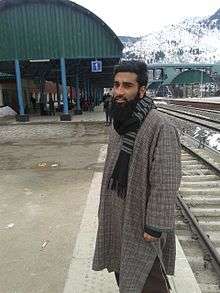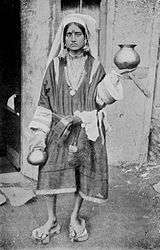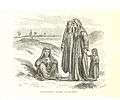Phiran

The traditional outfit for both males and females in Kashmir is the Phiran and poots.[1] The phiran and poots consist of two gowns, one over the other.[2] The traditional phiran and poots extends to the feet, which was popular up to the late 19th century C.E.[3] However, a relatively modern variation of the phiran and poots extends to below the knees,[4] which is worn with a suthan (loose form of shalwar) similar to the styles worn in Afghanistan.[5][6] It is optional to wear the suthan with a long phiran as traditionally lower garments are not worn with phirans. The traditional phiran and poots do not have side slits.
In summer, the phiran and poots are made of cotton, but in winter, the poots are made out of cotton and the phiran of wool, covering and protecting the body from the cold. These dresses are used by the residents of the Kashmir valley.
Etymology
There is no consensus as to the origin of the word 'phiran'. However, it seems that the word is a corruption of the Persian word 'perahan' which means shirt. The outfit has been envogue in Kashmir since before the 15th century.[7]
Design
Head dress
Hindu females use a “taranga”, a headdress which becomes smaller down at back, towards the heels. Islamic Kashmiri females use a red headwear known as the “kasaba”. The kasaba is padded by means of a turban and is pinned together by brooches. A pin-scarf revoked from the kasaba descends towards the neck.
Phiran

The phiran is a loose upper garment loosely gathered at the sleeves which tend to be wide,[8] made of either wool or jamewar which is a mixture of wool and cotton,[9] with no side slits. A phiran made of wool is called a 'loch'.[10] Female phiran dresses are designed with colorful flower elements and styles. Male phiran dresses are quite simple without any colourful designs.
The traditional phiran falls to the feet like a gown[11] which was universally worn by the Hindu and Muslim communities into the later 19th century C.E.[12] However, a modern version is knee-length and is worn by Muslim people which is loose and stitched at the front side and on the finishes while Hindu people wear their phirans long, extending down their legs. Ankle length Phirans[13] are tied at the waist.[14] Intricate embroideries or flower styles are a popular function of a Kashmiri ladies phiran.
Poots
The poots is the same as the phiran but made of lighter material and is worn beneath the phiran.
Suthan/shalwar
Traditionally, the phiran and poots were worn without a lower garment.[15][16] Indeed, in neighbouring Hunza too, women did not wear pajamas until 1890 and in Nagar until 1925.[17] Since the latter part of the 19th century, loose suthans (shalwars) and churidar pajamas of the Punjab region became popular in Kashmir.[18][19] Accordingly, the suthan or churidar pajama can form part of the phiran and poots ensemble but is not a must. The Kashmiri suthan is baggy and loose and is similar to the Dogri suthan worn in the Jammu region. Some versions are similar to the shalwars worn in Afghanistan. However, since the 1960s, the straight cut Punjabi salwar has become popular.[20][21][22]
Kanger
A Kanger(Kashmiri: कांगर (Devanagari), کانگر (Nastaleeq); (also known as Kangri) is traditionally used to keep warm and is worn under the phiran. However, current medical advice is not to use the kangar.
Modern fashion
Modern trends saw a decline in the use of phirans in favour of the shalwar kameez.[23] However, there has been a revival in recent years as phirans have become part of modern fashion,[24] and are worn by females of other areas of India as well.[25] Kashmiri men are also wearing the phiran as a fashionable outfit.[26] Combined with jeans, the phiran has made its way into the office world.[27] The modern phiran is not as wide and long[28] as the traditional ankle or knee length versions and sometimes have side slits. Less men are wearing the phiran with a shalwar.[29]
Photo gallery
-

Phiran worn by Pandit woman 1922 vintage by Vishwanath
-

Kashmiri Pandits in Phiran and pajama
-
Left and right: Phiran Shalwar; centre: Punjabi suits
-

Kashmiri Muslim women in traditional long Phiran 1870
-
A local at Srinagar
-

Traditional Dresses of Kashmir
-

Kashmiri Ornamental Kanger
-
A youth at Srinagar
-
.jpg)
Kashmiris wearing Phirans (1895)
-

Men in Kashmiri Phiran and Poots 1875
See also
References
| Look up phiran in Wiktionary, the free dictionary. |
- ↑ Kashmir Through Ages (5 Vol) By S. R. Bakshi
- ↑ Colonel Tej K Tikoo (2013) Kashmir: Its Aborigines and Their Exodus
- ↑ Letters from India and Kashmir (1874)
- ↑ Raina, Mohini Qasba (2013) Kashur The Kashmiri Speaking People
- ↑ Asoke Kumar Bhattacharyya, Pradip Kumar Sengupta Foundations of Indian Musicology: Perspectives in the Philosophy of Art and Culture (1991)
- ↑ Bamzai, P. N. K. (1994) Culture and Political History of Kashmir, Volume 1
- ↑ Dewan, Parvez (2004) Parvéz Dewân's Jammû, Kashmîr, and Ladâkh: Kashmîr
- ↑ Forster, George (1808) A Journey from Bengal to England, Through the Northern Part of India, Kashmire, Afghanistan, and Persia, and Into Russia, by the Caspian-Sea, Volume 2
- ↑ Asoke Kumar Bhattacharyya, Pradip Kumar Sengupta Foundations of Indian Musicology: Perspectives in the Philosophy of Art and Culture (1991)
- ↑ The Phoenix, Volume 3 (1883)
- ↑ Jain, Simmi (2003) Encyclopaedia of Indian Women Through the Ages: The middle ages
- ↑ Letters from India and Kashmir (1874) Muslim women are shown as recent as 1870 wearing the long Phiran
- ↑ "How Kashmiris keep themselves warm during winter - Kazinag". Sites.google.com. Retrieved 2014-07-31.
- ↑ Kashmir, Volumes 2-3 (1952)
- ↑ Cultural Heritage of India- Kashmiri Pandit Contribution. The Publication of Kashmir Sabha, Calcutta (1999-2000)
- ↑ Irby, Augustus Henry (1863) The diary of a hunter from the Punjab to the Karakorum mountains
- ↑ Chohan,Amar Singh (1893) Historical Study of Society and Culture in Dardistan and Ladakh
- ↑ Kumar, Raj (2006) Paintings and Lifestyles of Jammu Region: From 17th to 19th Century A.D.
- ↑ Kapur, Manohar Lal (1992) Social and economic history of Jammu and Kashmir State, 1885-1925 A.D.
- ↑ India. Office of the Registrar General (1961) Census of India, 1961: Jammu and Kashmir
- ↑ Dorris Flynn (1986) Costumes of India
- ↑ Shri Parmananda Research Institute, 1982 Glimpses of Kashmiri Culture, Volume 5
- ↑ Dhar, Somnath (1999( Jammu and Kashmir
- ↑ Piyali Bhattachary (14.04.2015)Khadi Couture: How to Wear Kashmiri Tweed Wall Street Journal
- ↑ "Clothing in Kashmir". Kashmir Travel Information. Retrieved 2014-07-31.
- ↑ Ishfaq-ul-Hassan (11.02.2015) DNA Real aping reel: Kashmir valley gripped by 'Haider' pheran feve
- ↑ Rashid, Toufiq (29.22.2014) Hindustan Times. Pheran making a political statement in Kashmir
- ↑ (Hassan, Firdous (11.02.2015) The Kashmir Monitor. With e-commerce 'Pheran' goes global
- ↑ Medhora, Sarosh (02.09.2000) The Tribune. Focus on men’s formals